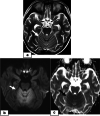Neuroimaging findings of posterior reversible encephalopathy syndrome (PRES) following haematopoietic stem cell transplantation in paediatric recipients
- PMID: 34629063
- PMCID: PMC8504064
- DOI: 10.1186/s12887-021-02890-y
Neuroimaging findings of posterior reversible encephalopathy syndrome (PRES) following haematopoietic stem cell transplantation in paediatric recipients
Abstract
Background: Haematopoietic stem cell transplantation (HSCT) is used worldwide in various malignant and nonmalignant childhood diseases, including haematologic, genetic, autoimmune and metabolic disorders, and is the only curative treatment for many of these illnesses. The survival rates of many childhood diseases have been increased due to HSCT treatment. However, associated complications are still important for management. Central nervous system (CNS) complications in paediatric HSCT recipients can be associated with high morbidity and significantly contribute to mortality. Posterior reversible encephalopathy syndrome (PRES) is one of the most common CNS complications in patients with neurological symptoms following HSCT. Magnetic resonance imaging (MRI) is the modality of choice and shows typical bilateral vasogenic oedema at the posterior parts of the cerebral hemispheres; however, various atypical imaging manifestations can also occur. In this study, we retrospectively examined CNS complications in our paediatric HSCT recipients with a focus on the typical and atypical neuroimaging manifestations of PRES following HSCT.
Methods: We retrospectively reviewed the medical records of 300 consecutive paediatric HSCT recipients from January 2014 to November 2018. A total of 130 paediatric HSCT recipients who experienced neurological signs and symptoms and were evaluated with neuroimaging studies following HSCT were enrolled in the study. The timing of CNS complications was defined according to immune status, including the pre-engraftment period (< 30 days after HSCT), the early postengraftment period (30-100 days after HSCT), and the late postengraftment period (> 100 days after HSCT), which were defined as phases 1, 2 and 3, respectively.
Results: Overall, 130 paediatric HSCT recipients experienced neurological signs and symptoms and therefore underwent neuroimaging examinations. Among these 130 patients, CNS complications were present in 23 patients (17.6%, 23/130), including 13 (56.5%) females and 10 (43.5%) males with a median age of 8.0 years (range, 8 months to 18.0 years). Among these 23 patients, 14 cases of PRES (60.9%), 5 (21.7%) cases of leukoencephalopathy, 3 cases of acute subdural haemorrhage (ASDH) (13%) and 1 (4.3%) case of fungal CNS infection were identified by neuroimaging. On MRI, typical parietooccipital vasogenic oedema was present in 78.5% of the PRES cases (11/14). The following atypical neuroimaging manifestations were observed: isolated involvement of the bilateral frontal lobes in 1 case, isolated cerebellar vermis involvement in 1 case, and isolated basal ganglia involvement in 1 case. Restricted diffusion associated with cytotoxic damage was demonstrated in 2 of 14 cases, one of which also showed subacute cytotoxic injury with ADC pseudonormalization.
Conclusion: Paediatric HSCT recipients presenting with CNS signs and symptoms should be evaluated by neuroimaging studies for timely diagnosis and early management. PRES is the most common CNS complication and may present with atypical MRI manifestations, which should not dissuade a PRES diagnosis in appropriate clinical settings.
Keywords: CNS complications; Haematopoietic stem cell transplantation; MRI; PRES; Posterior reversible encephalopathy syndrome.
© 2021. The Author(s).
Conflict of interest statement
none.
Figures







References
-
- Straathof K, Anoop P, Allwood Z, Silva J, Nikolajeva O, Chiesa R, et al. Long-term outcome following cyclosporine-related neurotoxicity in paediatric allogeneic haematopoietic stem cell transplantation (original research) Bone Marrow Transplant. 2017;52(1):159–162. doi: 10.1038/bmt.2016.232. - DOI - PMC - PubMed
MeSH terms
LinkOut - more resources
Full Text Sources

